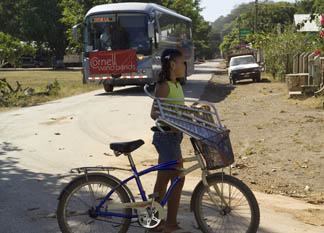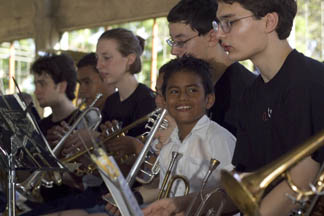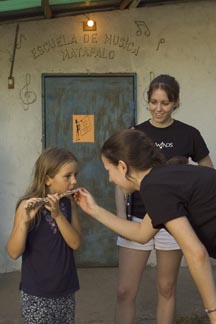'Excelente' -- CU Winds score a hit for friendship in Costa Rica
By Daniel Aloi


On the morning of Jan. 13, in dry 85-degree weather, the Cornell University Wind Ensemble arrived to make music with and for the citizens of Matapalo -- a small, dusty village near the Pacific Ocean.
The 38 Cornell students stacked their instruments on a long row of tables on one side of the pavilion as they set up for the day in the village's community center, a large cement-floored pavilion with a tin roof and handmade tables and stools, across the road from the town soccer field, rodeo arena and fiesta grounds.
Then the first students from the local music school, the Escuela Música de Matapalo, began to arrive, some walking down the road with their own instruments, and CU Winds music director Cynthia Johnston Turner greeted them as, one by one, they entered: "Saxophone!" "Saxophone!" "Trombone!" "Trompeta!"
The Cornell students had landed Jan. 12 in Liberia, Costa Rica, for the first leg of a concert tour of the country, centered on concerts and workshops with local music students from rural Matapalo, in the northwestern province of Guanacaste. Everywhere the students are being met with smiling faces and applause.
The traveling contingent also includes two musicians from Ithaca College, music major Nikola Tomic and alumna Cayenna Ponchione. Turner's husband, Peter, assistant dean for administration at Cornell's College of Architecture, Art and Planning, is also with the tour.
Because of a school holiday, about two dozen Matapalo students, ranging in age from about 6 to 18, were present for the Cornell visit.
After greetings were exchanged, musical friendships struck up almost immediately. The visitors began showing their young hosts various instruments, and a musical cacophony filled the hall. One of the younger locals drummed out a tattoo on a snare, and four older boys jammed on a marimba. The sounds of horns and woodwinds and drums rose up from every direction, as a group of cowboys -- sabaneros -- drove a pack of horses out to pasture just outside the pavilion.

The Cornell ensemble then invited the local students to sit beside them in concert formation with their respective instruments, and they played together as a rehearsal for an afternoon concert for the town. Turner -- "Dr. Cindi" to the locals -- and Matapalo's music director, Tomás Guadamuz Zuñiga, took turns conducting.
The combined group rehearsed the afternoon's repertoire, including the national anthems of the United States, Costa Rica and Turner's native Canada, as well as the Cartoon Symphony -- a selection of theme songs from "The Jetsons," "The Flintstones," "The Pink Panther," "The Simpsons" and the Bugs Bunny themes from Warner Brothers cartoons.
"The piece Tomás chose was perfect for kids -- because kids must see these shows here," said percussionist Robert Whalen '06, one of two music majors in the CU Winds. "I think I worked with the youngest people here to one of the oldest people here. What struck me today is even though we didn't know how to say everything about the music, just playing it with them got it across."
After rehearsal, the group broke into several small workshop sessions, with the Cornell players giving personal instruction to the youngsters. CU Winds members had learned some Spanish phrases and musical terminology prior to the tour.
"So many were at different levels. With one of the older ones, who's 14, we were able to refine his technique," Whalen said. "He could play single-stroke gestures, but when it came to rolling, he got it in two tries -- both Patrick (Yu '06) and I said, 'Excelente!' That was the victory of the day. The moment of clarity when we thought, 'OK, we can do this.'"
Michael Barany '09, a mathematics major, worked with a young trumpeter named Gabriel.
"He had such enthusiasm for playing; he was willing to try anything," Barany said. "The language asymmetry provided a different structure of authority. I could see he really took delight in finishing my sentences, and it was more give-and-take.
"Being from different cultures, and having different languages, we're all playing the same instrument and that's enough to make us comfortable. When we were playing as a whole ensemble, it seemed the other trumpet players felt confident to jump in and add things."
The Matapalo students clearly enjoyed themselves in the workshop session, Whalen said. "With the smaller ones, it was mostly about teaching them ensemble playing and steady rhythm. Cayenna [Ponchione] and I decided to make it a full-body exercise. We were teaching just basic beats, and they were all smiling and having fun and hitting each other with their instruments. As a music professional, people are often so serious. But it seemed very joyful and communicative."
Following a picnic lunch served by the community, it was concert time. The Matapalo musicians performed first, with a hearty, enthusiastic set of traditional songs accompanied by Los de la Bajura Costena, one of four traditional dance groups in Matapalo, who wore white costumes accented by colorful sashes, scarves and hems. Then the young students joined the CU Winds to play a 45-minute concert.
"What a fine and wonderful day we've had in Matapalo," Johnston Turner said to the audience just before finishing with the Cartoon Symphony. "What a treat it was to work with Tomás' musicians -- and we learned a lot ourselves."
"We're happy to play with new friends," Zuñiga added. All the musicians involved were presented with orange CU Winds/Matapalo Band t-shirts and Johnston Turner presented Zuñiga with a red Cornell sweatshirt.
The next day, Jan. 14, both CU Winds and the Matapalo band traveled to the semiannual Cultural Festival in Santa Cruz, Guanacaste's municipal seat, where the wind ensemble gave a concert for a crowd of about 4,000 people. The program included the Costa Rican anthem, Sousa's "Black Horse Troop March," Ron Nelson's "Rocky Point Holiday" and, with the brassy Matapalo band onstage, Eric Osterling's "Totem Pole."
"The concert at Santa Cruz was pretty amazing because that's probably the largest crowd I've ever played for," Morgan said. "Our concerts at Cornell are not as well-attended as we'd like them to be. It was really good to be so appreciated. The people were glad that we were there."
After Santa Cruz, the tour is moving cross-country to the capital city of San José for more concerts, including performances presented by the U.S. Embassy and the National Cultural Center in Costa Rica, a concert for American students at the Country Day School and a show at a senior citizens' center.
Media Contact
Get Cornell news delivered right to your inbox.
Subscribe